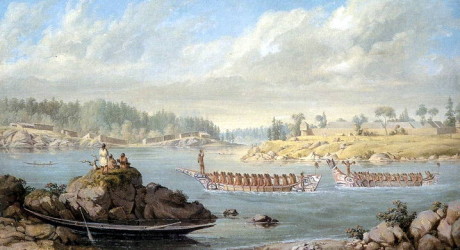Raiders from the North
Posted January 7, 2015 at 5:49 am by Tim Dustrude
Join San Juan Island National Historical Park Historian Mike Vouri for an illustrated talk about the impact of northern Indian raids in the Salish Sea scheduled for 7:00 pm on Wednesday, January 14 at the San Juan Island Library.
Fears of Northern Indians ‑ defined by whites in the 19th century as groups from today’s northern British Columbia, Southeast Alaska and the Queen Charlotte Islands ‑ were a constant in Puget Sound and the Salish Sea long before American homesteads sprang up on the shorelines in the late 1840s. For hundreds of years, the Lummi and other Coast Salish shore‑dwelling groups in the south were victimized by groups from the Straits of Georgia and as far north as southeast Alaska.
Vouri’s “Raiders from the North: The Northern Indians in Northwest Washington” won the 1997 John McClelland Jr. Award as the best article published in Columbia Magazine, the journal of the Washington State Historical Society.
He re-visited the topic in November 2014 in a presentation for the Discover Ebey’s Landing conference in Coupeville, WA.
“I’ve never really left the topic, accumulating a file drawer full of journal articles and primary sources,” Vouri said. “The raids played a major role in opening the door to European settlement in the region, north and south of the border. Some of the oral histories taken in the mid-20th century are quite moving.”
Here’s a fragment from one account:
“For many, many years, all the in the bright summer weather, they have come down upon us, those Ukultahs of the North,” according to a Saanich chief interviewed in 1932. “They have killed our men and taken away our women to slavery. Every year they come, and nobody knows whose house shall be left desolate with the coming of summer. For they are many and strong, and their war canoes are upon the sea as the salmon in the spawning season at the river mouth.”
Labor was the most valuable commodity on the Northwest Coast and slaves were the only form of labor that could be reliably controlled, according to one historian. While slaves were primarily raid and war captives, many were also born to it (females were preferred captives), a bonus for owners who bred them, much as plantation owners in the southeastern U.S., or ancient Rome for that matter, Vouri said.
“Owners could hire out or trade them, and it was not uncommon to sell one’s self into bondage to pay a debt,” he said.
Vouri will discuss how smallpox epidemics in the late 19th century decimated Salish groups, which made them especially vulnerable to the Lekwiltok, a southern clan of the Kwakiutl (or Kwakwaka’wakw) who raided from the northern Georgia Strait. The Salish groups united in 1830s and stopped these raids, but with the establishment of Fort Victoria in 1843-45, an entirely new threat emerged from further north which impacted Indians and Europeans alike.
“It was not until the arrival of U.S. and British steam warships that the later raids were curtailed,” Vouri said.
The program is free. Call the library at 378-2798 or the park at 378-2240, ext. 2227 for more information.
You can support the San Juan Update by doing business with our loyal advertisers, and by making a one-time contribution or a recurring donation.
Categories: Around Here











No comments yet. Be the first!
By submitting a comment you grant the San Juan Update a perpetual license to reproduce your words and name/web site in attribution. Inappropriate, irrelevant and contentious comments may not be published at an admin's discretion. Your email is used for verification purposes only, it will never be shared.